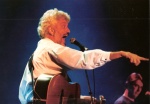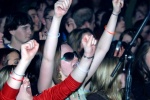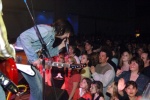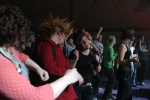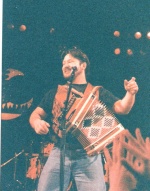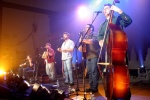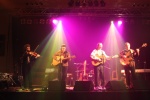Nuit sur l’Étang: a Nocturnal Frenzy of Franco-Ontarian Partying
par Pichette, Marie-Hélène
In March of 1973, a few students from Laurentian University in Sudbury (Ontario), under the supervision of Professor Fernand Dorais, organized an event showcasing a variety of artists to be held at the end of the conference. A number of Franco-Ontarian musicians, performers, and poets took to the stage of the Fraser Auditorium to provide a memorable evening of entertainment. And so, Nuit sur l'Étang [A Night at the Pond] was born. More than 35 years have passed since that first night, yet the event still attracts a regular audience. In spite of many difficulties and changes over the years, Nuit sur L'Étang has continued to pursue its original goal of showcasing up-and-coming artists, while offering Franco-Ontarians an occasion to celebrate. On one evening a year, people from all over the province rally together to celebrate what has been called the "collective Franco-Ontarian frenzy." (NOTE 1)
Article disponible en français : Nuit sur l'étang: « la folie collective d'un peuple en party »
The Birth of a Cultural Event
The 1970s were a time of effervescence in which the cultural identity of Franco-Ontarians began to emerge. The growing cultural movement gave rise to the Théâtre du Nouvel-Ontario [Theatre of Northern Ontario] (TNO, 1970), the Prise de Parole publishing house (1973), the Coopérative des Artistes du Nouvel-Ontario [Artists' Cooperative of Northern Ontario] ) (CANO, 1971), and the creation of the Franco-Ontarian flag (1975). In the field of music, three advocates of Franco-Ontarian music burst on the scene at the same time: the CANO music group, Garolou, and the singer-songwriter Robert Paquette
Nuit sur l'Étang was born in 1973, during a time when the burgeoning identity of French-speakers in Quebec fractured French-Canadian society and led to a collective identity crisis among French-speaking Ontarians.(NOTE 2) It was from this time on that young French-speaking Ontarians who had sympathized with the Quebec movement would begin to refer to themselves as Franco-Ontarians instead of French-Canadians. It was also the same group of Franco-Ontarians that decided to organize a giant party to conclude the Franco-Parole conference. The objective of the conference had been to identify the needs and interests of Laurentian University's French-speaking minority. In only a few days, under the direction of Professor Fernand Dorais, a group of students laid the groundwork for what was to become the very first Nuit sur l'Étang.
From the very start, the organizing committee decided that the event would be an all night ‘happening', along the lines of an American-style show in which the spontaneous and the unpredictable are essential.(NOTE 3) Then, the committee set up a network of busses to the event that would make it possible for young Franco-Ontarians from the entire province to attend the major ‘happening'. Finally, it was decided that artistic creativity would be one of the central features of the event. This spirit of openness would enable artists from a wide variety of disciplines (music, poetry, theatre, the visual arts, etc.) to present original works entirely in French. As for the origins of the show's name, Nuit [night] refers to the all-night event, whereas Étang [pond] is a tongue-in-cheek allusion to the enduring but not endearing nickname of "frogs" that had been given to the French Canadians by English speaking Canadians. The first very modest celebration on March 6th, 1973 drew an audience of about 200 spectators.
An Unexpected Success
Neither did the scant resources available for the initial event, nor did the modest crowd it drew prevent the event from being held the following year. With the exception of 1977 and 2005, this major cultural event has been held every year since it started and its legendary success precedes it even today.
The organizers of subsequent events sought to establish and consolidate certain basic principles: that Nuit sur l'Étang would remain an evening of Franco-Ontarian creativity; it would feature a wide variety of artists; and it would conform to certain standard requirements (no sets would be used, all artists would receive the same fee, etc.), so that the performances would remain centred on the community rather than on individuals.(NOTE 4) It would also take place every March and be called Nuit sur l'Étang. The organizers sought to balance provincial participation in the event, but, nevertheless, a majority of the artists ended up coming from Northern Ontario. Performers such as Robert Paquette(NOTE 5), Rachel Paiement(NOTE 6), and Cano Musique(NOTE 7) very quickly became familiar guests at the festival.
Starting with very second festival, which coincided with the launching of Robert Paquette's first album, Radio-Canada has been present to record the festival's various numbers and has ever since broadcast highlights from the various performances on its national network.(NOTE 8) In 1979, it was decided that the festival would no longer showcase artists from a number of artistic disciplines, but would instead focus strictly on music. The event would also be open to Quebec artists.(NOTE 9)
In 1983, the 10th edition of Nuit sur l'Étang proved to be a pivotal moment in the history of the festival. The organizing committee decided that it would endeavour to return to the founding principles and take every step necessary to ensure the survival of the event, which, by this time had become recognized as a cultural institution. Once again, the festival line-up included exclusively Franco-Ontarian numbers, and artists from the early days, such as CANO and Robert Paquette, were invited to perform. The committee launched a new contest they named La Brunante de la Nuit [The Twilight](NOTE 10) and established the Nouvel-Ontario Prize that was to be awarded at each year's event to recognize the excellence of a Franco-Ontarian's works in the area of arts and humanities.(NOTE 11) To top off this momentous year, CANO's hit song Venez nous voir [Come See Us] became the festival's hit song and was sung as the event's anthem at the opening of future festivities. The organisers gamble paid off, breathing new life into the revamped event and ended up attracting just over 1,000 spectators.
Change and Renewal
Nuit sur l'Étang has evolved over the years, and though the festival's objectives have sometimes been interpreted in controversial ways, these guiding principles have always remained clear throughout the many and often necessary changes that the event has undergone. In 1984, in an effort to foster more creativity, the organizers established the Bourse Bertrand [Bertrand Grant], which was to be awarded to the artist who presented the best song of the event.(NOTE 12) 1988 was the year the first Gala de la Nuit (an official soirée preceding the main event) took place. This major new feature was specifically designed to showcase talented artists who had not been selected to perform at the event itself. The Gala was also an occasion to recognise those institutions and major public figures who had contributed to Franco-Ontarian musical life.
In order to meet another of the committee's objectives-namely "to put on a show on a professional stage and to raise national awareness of the event"(NOTE 13)-the organizing committee invited yet another television crew in 1988. This time TV Ontario's French Channel was brought in to film the show. In 1991, the local television crew was replaced by "Radio-Canada (SRC), a national level television production crew."(NOTE 14) These recordings made it possible for the event to have a wider viewership, in hopes of drawing even more spectators. From 1988 to 1996, measures were taken to invite artists from outside the province, A decision that proved to be particularly controversial, as many long-time spectators considered Nuit sur l'Étang to be an exclusively Franco-Ontarian affair.
In 1996, a new executive director revived the original founding principles of the show. She insisted on returning to a purely Franco-Ontarian program and took the risky step of transferring the event to a much larger space. Two years later, Nuit sur l'Étang celebrated its 25th anniversary at the Municipal Arena before a record crowd of 1,500 spectators; there, artists from the very first 1973 edition of the festival joined forces with a new generation of musicians and artists.
The next 10 years were a decade of experimentation. Following the success of the 25th anniversary production, the organizers dared to make a number of changes intended not only to retain the audience and to diversify program content, but also to cope with the event's serious financial limits. The show changed dates and locations (moving from March to October one year and then eventually back to the popular March festival date, as well as transferring from the Municipal Arena to a college auditorium). Its program would remain essentially Franco-Ontarian, although other French-speaking artists from neighbouring Quebec and the rest of Canada were also invited to perform. And so, despite all these changes, Nuit sur l'Étang continues to attract large crowds after more than 35 years and it does not appear ready to stop doing so.
Still Alive and Well
The very fact that the program has survived for this long shows that it has managed to meet and adjust to the many challenges that have arisen along the way. In 2008, the program objectives were still to offer support to young people and artists by giving them access to a professional stage; by teaching them traditional stage techniques; and by giving them a sense of belonging to the Franco-Ontarian community."(NOTE 15) In order to ensure that the event keeps up with the times, the organizing committee will have to continue adapting to the ever-changing arena of performing arts. In order to achieve this in future years, the committee intends to assemble a team of individuals from various backgrounds whose goal is to integrate the latest effective broadcasting technology into the festival.
For many members of the Franco-Ontarian community, Nuit sur l'Étang is a "veritable monument to their culture. Year in and year out, the program helps develop and showcase Northern Ontario's most promising French-speaking artists, as well as preserving heritage that is characteristic and emblematic of the province's history. What makes Nuit sur l'Étang even more remarkable is that each year it reaches more and more young people, raising their awareness of their distinct culture, all the while reinforcing their feelings of belonging."(NOTE 16)
Marie-Hélène Pichette
Ph. D. in Ethnomusicology, Université de Montréal
NOTES
Note 1. André Paiement, Franco-Ontarian playwright and singer-songwriter, who died tragically in 1978.
Note 2. Roger Bernard, De Québécois à Ontarois. La communauté franco-ontarienne, [Hearst], Le Nordir, [©1988], p. 36.
Note 3. Marie-Hélène Pichette, Musique populaire et identité franco-ontariennes. La Nuit sur l'étang, Sudbury, Prise de parole, « Ancrages », 2001, p. 20.
Note 4. Ibid., p. 47.
Note 5. Robert Paquette is one of the most famous Franco-Ontarian performers, both in Ontario and outside the province. He has participated in a number of Nuit sur l'Étang events.
Note 6., Rachel Paiement began her career with Cano Musique before leaving the group to pursue a solo singing career.
Note 7. Cano, the Coopérative des artistes du Nouvel-Ontario [Artists' Cooperative of Norther Ontario] was created in 1971 to promote Franco-Ontarian artists. It eventually gave rise to Cano Musique.
Note 8. The recording is called Toc Toc partout : la deuxième Nuit sur l'étang du 28 mars 1974, Montréal, Société Radio-Canada, 1974, video recording, 30 minutes.
Note 9. Pichette, Op. cit., p. 48.
Note 10. In the Brunante de la Nuit contest, the best high school musical acts in the region compete for a chance to perform at Nuit sur L'Étang. The contest is still held today. A number of workshops, in which professional musicians share their expertise with participants, are also held.
Note 11. Pichette, Op. cit., p. 49.
Note 12. Ibid., p. 84.
Note 13. Nuit sur l'étang website, http://lanuit.ca, page visited September 8th, 2008.
Note 14. Pichette, Op. cit., p. 84.
Note 15. Citation was taken from the program of the 35th edition of Nuit sur l'Étang.
Note 16. Nuit sur l'étang website, http://lanuit.ca, page visited September 8th, 2008.
BIBLIOGRAPHY
Albert, Pierre, Paul Demers, Ottawa, Éditions l'Interligne, 1992, 143 p.
Bernard, Roger, De Québécois à Ontarois. La communauté franco-ontarienne, Hearst, Le Nordir, 1988, 189 p.
Fournier-Thibault, Micheline, André Paiement (1950-1978). Avant tout un homme de son temps, Sudbury, Institut franco-ontarien/Prise de parole, « Ancrages », 2004, 203 p.
Lamothe, Maurice, La Chanson populaire ontaroise de 1970 à 1990 : ses produits, sa pratique, Ottawa/Montréal, Le Nordir/Triptyque, 1994, 391 p.
La Nuit sur l'étang, PAGE VISITED 10/09/08 [En ligne], http://lanuit.ca .
Liaison. La revue des arts en Ontario français.
Pichette, Marie-Hélène, Musique populaire et identité franco-ontariennes. La Nuit sur l'étang, Sudbury, Prise de parole, « Ancrages », 2001, 124 p.
Tremblay, Gaston, Prendre la parole. Le journal de bord du Grand CANO, Ottawa, Le Nordir, 1995, 332 p.
Additional DocumentsSome documents require an additional plugin to be consulted
Images
-
25e Nuit, article Le
Voyageur -
 25e Nuit, article Le
25e Nuit, article Le
Voyageur, suite -
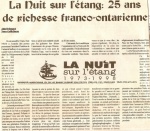 Article, 25 ans
Article, 25 ans
-
 Article, Le Voyageur,
Article, Le Voyageur,
18 mars 1998
Vidéo
Documents sonores
-
 Aux Illinois
Interpreter : Garolou.
Writer : Traditionnel.
Album : Tableaux d’hier, vol. 2, 1978.
Aux Illinois
Interpreter : Garolou.
Writer : Traditionnel.
Album : Tableaux d’hier, vol. 2, 1978.
-
 Baie Ste-Marie
Interpreter : CANO musique.
Writer : Marcel Frédéric Aymar, David Colin Burt, John Ward Doerr, Wasyl William Kohut.
Album : Tous dans le même bateau, 1976.
Baie Ste-Marie
Interpreter : CANO musique.
Writer : Marcel Frédéric Aymar, David Colin Burt, John Ward Doerr, Wasyl William Kohut.
Album : Tous dans le même bateau, 1976.
-
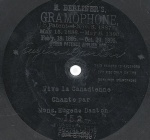 Bleu et blanc
Interpreter : Robert Paquette.
Writer : Robert Paquette.
Album : Prends celui qui parle, 1975.
Bleu et blanc
Interpreter : Robert Paquette.
Writer : Robert Paquette.
Album : Prends celui qui parle, 1975.
-
 Ça va brasser
Interpreter : Swing.
Writer : Michel Benac, Robert Raymond Lalonde.
Album : La chanson sacrée, 1999.
Ça va brasser
Interpreter : Swing.
Writer : Michel Benac, Robert Raymond Lalonde.
Album : La chanson sacrée, 1999.
-
 Electrique
Interpreter : Damien Robitaille.
Writer : Damien Robitaille.
Album : L’Homme qui me ressemble, 2006.
Electrique
Interpreter : Damien Robitaille.
Writer : Damien Robitaille.
Album : L’Homme qui me ressemble, 2006.
-
 Notre Place
Interpreter : Paul Demers.
Writer : Paul Demers.
Album : Paul Demers, 1990.
Notre Place
Interpreter : Paul Demers.
Writer : Paul Demers.
Album : Paul Demers, 1990.
-
 Ti-blanc
Interpreter : Robert Paquette.
Writer : Robert Paquette.
Album : Prends celui qui parle, 1975.
Ti-blanc
Interpreter : Robert Paquette.
Writer : Robert Paquette.
Album : Prends celui qui parle, 1975.

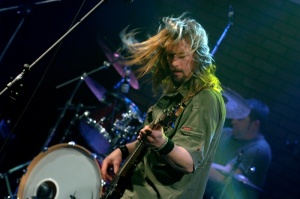
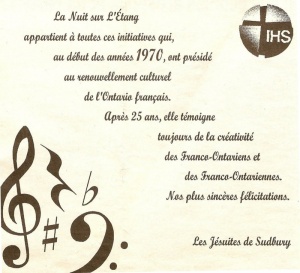
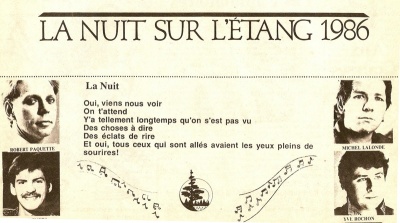
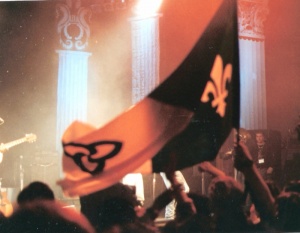
![Jean-Marc Lalonde & Loiuis Racine, La Ligue du Bonheur [League of Happiness], 2008](/media/thumbs/2045/300x200-Nuit_Jean-Marc_Lalonde_et_Louis_Racine_-_La_ligue_du_bonheur_-_2008.jpg)
